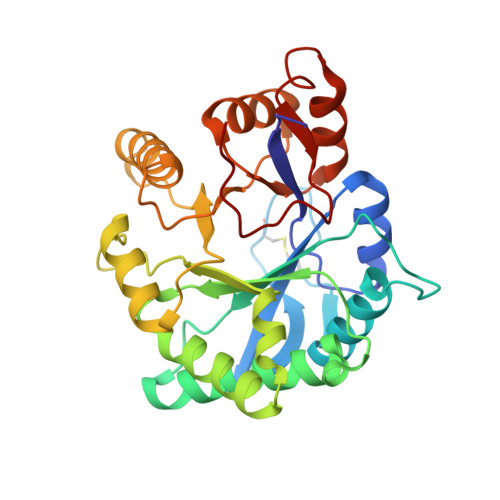Structural basis for metal ion coordination and the catalytic mechanism of sphingomyelinases D.
Murakami, M.T., Gabdoulkhakov, A., Fernandes-Pedrosa, M.F., Tambourgi, D.V., Arni, R.K.(2005) J Biological Chem 280: 13658-13664
- PubMed: 15654080
- DOI: https://doi.org/10.1074/jbc.M412437200
- Primary Citation of Related Structures:
1XX1, 2F9R - PubMed Abstract:
Sphingomyelinases D (SMases D) from Loxosceles spider venom are the principal toxins responsible for the manifestation of dermonecrosis, intravascular hemolysis, and acute renal failure, which can result in death. These enzymes catalyze the hydrolysis of sphingomyelin, resulting in the formation of ceramide 1-phosphate and choline or the hydrolysis of lysophosphatidyl choline, generating the lipid mediator lysophosphatidic acid. This report represents the first crystal structure of a member of the sphingomyelinase D family from Loxosceles laeta (SMase I), which has been determined at 1.75-angstrom resolution using the "quick cryo-soaking" technique and phases obtained from a single iodine derivative and data collected from a conventional rotating anode x-ray source. SMase I folds as an (alpha/beta)8 barrel, the interfacial and catalytic sites encompass hydrophobic loops and a negatively charged surface. Substrate binding and/or the transition state are stabilized by a Mg2+ ion, which is coordinated by Glu32, Asp34, Asp91, and solvent molecules. In the proposed acid base catalytic mechanism, His12 and His47 play key roles and are supported by a network of hydrogen bonds between Asp34, Asp52, Trp230, Asp233, and Asn252.
Organizational Affiliation:
Department of Physics, Instituto de Bioci¨ºncias, Letras e Ci¨ºncias Exatas/Universidade Estadual Paulista, S?o Jos¨¦ do Rio Preto, SP 15054-000, Brazil.


















